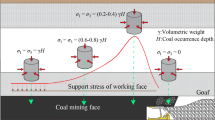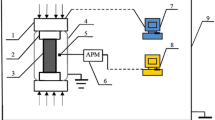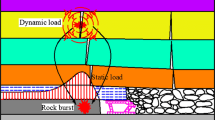Abstract
Dynamic collapses of deeply mined coal rocks are severe threats to miners. To predict the collapses more accurately using electromagnetic radiation (EMR), we investigate the time-varying multifractal characteristics and formation mechanism of EMR induced by underground coal mining. A series of uniaxial compression and multi-stage loading experiments with coal samples of different mechanical properties were carried out. The EMR signals during their damage evolution were monitored in real-time; the inherent law of EMR time series was analyzed by fractal theory. The results show that the time-varying multifractal characteristics of EMR are determined by damage evolutions process, the dissipated energy caused by damage evolutions such as crack propagation, fractal sliding and shearing can be regard as the fingerprint of various EMR micro-mechanics. Based on the Irreversible thermodynamics and damage mechanics, we introduced the damage internal variable, constructed the dissipative potential function and established the coupled model of the EMR and the dissipative energy, which revealed the nature of dynamic nonlinear characteristics of EMR. Dynamic multifractal spectrum is the objective response of EMR signals, thus it can be used to evaluate the coal deformation and fracture process.









Similar content being viewed by others
References
Bahat D, Rabinovitch A, Frid V (2005) Tensile fracturing in rocks: tectonofractographic and electromagnetic radiation methods. Springer Verlag, Berlin, p 570
Cress GO, Brady BT, Rowell GA (1987) Sources of electromagnetic radiation from fracture of rock samples in laboratory. Geophys Res Lett 14(4):331–334
Eftaxias K, Kapiris P, Polygiannakis J, Kopanas J, Antonopoulos G, Rigas D (2003) Experience of short term earthquake precursors with VLF-VHF electromagnetic emissions. NAT Hazards Earth Sys Sci 3:228–271
Eftaxias K, Panin VE, Deryugin YY (2007) Evolution-EM signals before earthquakes in terms of mesomechanics and complexity. Tectonophysics 431:273–300
Enomoto Y, Hashimoto H (1990) Emission of charged particles from indentation fracture of rocks. Nature 346:641–643
Fengnian J, Meirong J, Xiaoling G (2004) Defining damage variable based on energy dissipation. Chin J Rock Mech Eng 23(12):1976–1980
Freund F, Takeuchi A, Lau BWS, Post R, Keefner J, Mellon J, Al-Manaseer A (2004) Stress-induced changes in the electrical conductivity of igneous rocks and the generation of ground currents. Terr Atmos Ocean Sci 15:437–469
Frid V, Vozoff TK (2005) Electromagnetic radiation induced by mining rock failure. Int J Coal Geol 64:57–65
Fukui K, Okubo S, Terashima T (2005) Electromagnetic radiation from rock during uniaxial compression testing: the effects of rock characteristic and test conditions. Rock Mech Rock Eng 38(5):411–423
Ghomshei MM, Templeton TL (1989) Piezoelectric and a-axes fabric along a quartz vein. Phys Earth Planet Inter 55:374–386
Gokhberg MB, Morgounov VA, Yoshino T, Tomizawa I (1982) Experimental measurement of electromagnetic emissions possibly related to earthquakes in Japan. J Geophys Res 87(B9):7824–7828
Gotoh K, Hayakawa M, Smirnova NA, Hattori A (2004) Fractal analysis of seismogenic ULF emissions. Phys Chem Earth 29:419–424
Hadjicontis VE (2003) Evolving towards a critical point: a possible electromagnetic way in which the critical regime is reached as the rupture approaches. Nonlinear Process Geophys 10:511–524
Hayakawa M, Itoh T, Smirnova N (1999) Fractal analysis of geomagnetic ULF data associated with the Guam earthquake on August 8, 1993. Geophys Res Lett 26:2797–2800
Hayakawa M, Hattori K, Nickolaenko AP, Rabinowicz LM (2004) Relation between the energy of earthquake swarm and the Hurst exponent of random variations of the geomagnetic fields. Phys Chem Earth 29:279–378
He X, Nie B, Chen W, Wang E, Dou L, Wang Y, Liu M, Hani M (2012) Research progress on electromagnetic radiation in gas-containing coal and rock fracture and its applications. Saf Sci 50:728–735
Huang Q (2002) One possible generation mechanism of co-seismic electric signals. Proc Jpn Acad 78:173–178
Kapiris PG, Eftaxias KA, Chelidze TL (2004a) Electromagnetic signature of prefracture criticality in heterogeneous media. Phys Rev Lett 92:(065702-1–4)
Kapiris PG, Balasis GT, Kopanas JA, Antonopoulos GN, Peratzakis AS, Eftaxias KA (2004b) Scaling similarities of multiple fracturing of solid materials. Nonlinear Process Geophys 11:137–151
Kawada Y, Nagahama H, Hara H (2006) Irreversible thermodynamic and viscoelastic model for power-law relaxation and attenuation of rocks. Tectonophysics 427:255–263
Kawada Y, Nagahama H, Nakamura N (2007) Time-scale invariances in preseismic electromagnetic radiation, magnetization and damage evolution of rocks. Nat Hazards Earth Syst Sci 7:599–606
Lacidogna G, Carpinteri A, Manuello A, Durin G, Schiavi A, Niccolini G, Agosto A (2011) Acoustic and electromagnetic emissions as precursor phenomena in failure processes. Strain 47:144–152
Lyakhovsky V, Podladchikov Y, Poliakov A (1993) A rheologicalmodel of a fractured solid. Tectonophysics 226:187–198
Mandelbrot BB (1982) The Fractal Geometry of Nature. W. H Freemann and Company, San Francisco
Martelli G, Smith PN, Woodward AJ (1989) Light, radio frequency emission and ionization effects associated with rock fracture. Geophys J Int 98:397–401
Masugi M, Takuma T (2007) Multi-fractal analysis of IP-network traffic for assessing time variations in scaling properties. Physica D 225:119–126
Minadakis G, Stylianos M, Constantinos N, Potirakis, Eftaxias K (2012) Linking electromagnetic precursors with earthquake dynamics: An approach based on nonextensive fragment and self-affine asperity models. Physica A 391:2232–2244
Miura T, Nakayama K (2001) Two-dimensional spatial distribution of electric-discharge plasma around a frictional interface between dielectric surfaces. Appl Phys Lett 78:2979–2981
Morgounov VA, Malzev SA (2007) A multiple fracture model of pre-seismic electromagnetic phenomena. Tectonophysics 431:61–72
Muto J, Nagahama H, Miura T, Arakawa I (2006a) Frictional discharge plasma from natural semiconductor/insulator junctions: origin of seismo-electromagnetic radiation. Phys Chem Earth 31:346–351
Muto J, Nagahama H, Miura T, Arakawa I (2006b) Frictional discharge from sheared asperities: implication for fractal seismoelectromagnetic radiation. Trans IEE Jpn 126:242–243
Muto J, Nagahama H, Miura T, Arakawa I (2007) Frictional discharge an fault asperities: origin of fractal seismo-electromagnetic radiation. Tectonophysics 431:113–122
Nagahama H, Teisseyre R (1998) Thermodynamics of line defects and transient electric current: electromagnetic field generation in earthquake preparation zone. Acta Geophys Pol 46:35–54
Nan L, Enyuan W, Enlai Z, Yankun M, Fule X, Weihua Q (2010) Experiment on acoustic emission of rock damage and fracture under cyclic loading and multi-stage loading. J China Soc 35(7):1100z–1103z
Nanjo K, Nagahama H (2004a) Fractal properties of spatial distributions of aftershocks and active faults. Chaos Solitons Fractals 19:387–397
Nanjo K, Nagahama H (2004b) Discussions on fractals, aftershocks, and active faults: diffusion and seismo-electromagnetism. Arab J Sci Eng 29:147–167
Nitsan V (1977) Electromagnetic emission accompanying fracture of quartz bearing rocks. Geophys Res Lett 4(8):333–335
Ogawa T, Oike K, Miura T (1985) Electromagnetic radiations from rocks. J Geophys Res 90(d4):6245–6249
O’Keefe SG, Thiel DV, Davey N (2000) Fracture induced electromagnetic emissions in the mining industry. Int J Appl Electromagn 12:203–209
Peng R, Xie H, Ju Y (2007) Analysis of energy dissipation and damage evolution of sandstone during tensile process. Chin J Rock Mech Eng 26(12):2527–2531
Potirakis SM, Minadakis G, Eftaxias K (2012) Analysis of electromagnetic pre-seismic emissions using Fisher information and Tsallis entropy. Phys A 391:300–306
Rabinovitch A, Frid V, Bahat D (2001) Gutenberg–Richter-type relation for laboratory fracture-induced electromagnetic radiation. Phys Rev E 65:(011401-1–4)
Rabinovitch A, Shay A, Liraz R, Frid V, Bahat D (2005) Electromagnetic radiation emitted during friction process. Int J Fract 131:L21–L27
Rabinovitch A, Frid V, Bahat D (2007) Surface oscillations—a possible source of fracture induced electromagnetic radiation. Tectonophysics 431:15–21
Song D, Wang E, Liu J (2012) Relationship between EMR and dissipated energy of coal rock mass during cyclic loading process. Saf Sci 50(4):751–760
Swoboda G, Yang Q (1997) Damage propagation model and its application to rock engineering problems. In: Proceedings of the seventh international congress on rock mechanics, Tokyo, pp 159–163
Takeuchi A, Nagahama H (2006) Electric dipoles perpendicular to a stick–slip plane. Phys Earth Planet Inter 155:208–218
Triantis D, Stavrakas I, Anastasiadis C, Kyriazopoulos A, Vallianatos F (2006) An analysis of pressure stimulated currents (PSC), in marble samples under mechanicsl stress. Phys Chem Earth 31:234–239
Tsutsum A, Shirai N (2008) Electromagnetic signals associated with stick–slip of quartz-free rocks. Tectonophysics 450:79–84
Tzanis A, Vallianatos F, Gruszow S (2000) Identification and discriminationof transient electrical earthquake precursors: fact, fiction and some possibilities. Phys Earth Planet Inter 121:223–248
Valanis KC (1995) The physical metric in thermodynamics. Acta Mech 113:169–184
Vallianatos F, Triantis D, Tzanis A, Anastasiadis C, Stacrakas I (2004) Electric earthquake precursors: from laboratory results to field observations. Phys Chem Earth 29:339–351
Wang Y, Zhu YS (2001) A short-time multifractal approach for arrhythmia detection based on fuzzy neural network. IEEE Trans Biomed Eng 48(9):989–995
Wang E, He X, Liu X (2012) Comprehensive monitoring technique based on electromagnetic radiation and its applications to mine pressure. Saf Sci 50(4):885–893
Warwick JW, Stoker C, Meyer TR (1982) Radio emission associated with rock fracture: possible application to the great Chilean earthquake of May22, 1960. J Geophys Res 87(B4):2851–2859
Wei J, He X, Wang E, Liu Z (2005) Electromagnetic emission multi-fractal characteristic of coal and gas outburst. J Liaoning Tech University 24(1):1–4
Xiong G, Zhang S, Liu Q (2012) The time-singularity multifractal spectrum distribution. Phys A 391:4727–4739
Yao J, Yan Y, Shui G, Yao J, Li S (2010) Study of fractal characteristics of electromagnetic emission during coal and rock mass fracture. Chin J Rock Mech Eng 29(2):4103–4107
Acknowledgments
This work is supported by The 12th Five Year National Science, Technology Support Key Project of China (2012BAK04B07-2,2012BAK09B01-04), National Natural Science Foundation of China (51104156) and High Lever Paper Special Found Supported by CUMT (2012LWBZ04). The authors are grateful to all the coal mines mentioned in the paper for providing experimental environments.
Author information
Authors and Affiliations
Corresponding author
Rights and permissions
About this article
Cite this article
Hu, S., Wang, E., Li, Z. et al. Time-Varying Multifractal Characteristics and Formation Mechanism of Loaded Coal Electromagnetic Radiation. Rock Mech Rock Eng 47, 1821–1838 (2014). https://doi.org/10.1007/s00603-013-0501-9
Received:
Accepted:
Published:
Issue Date:
DOI: https://doi.org/10.1007/s00603-013-0501-9




